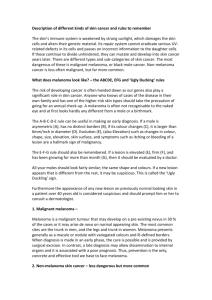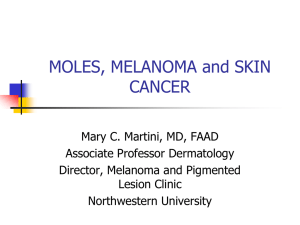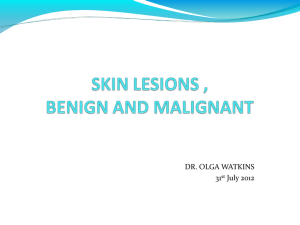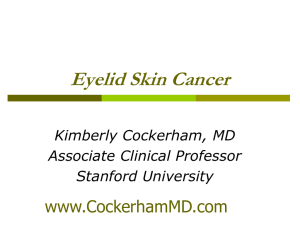View the MS Word file HERE
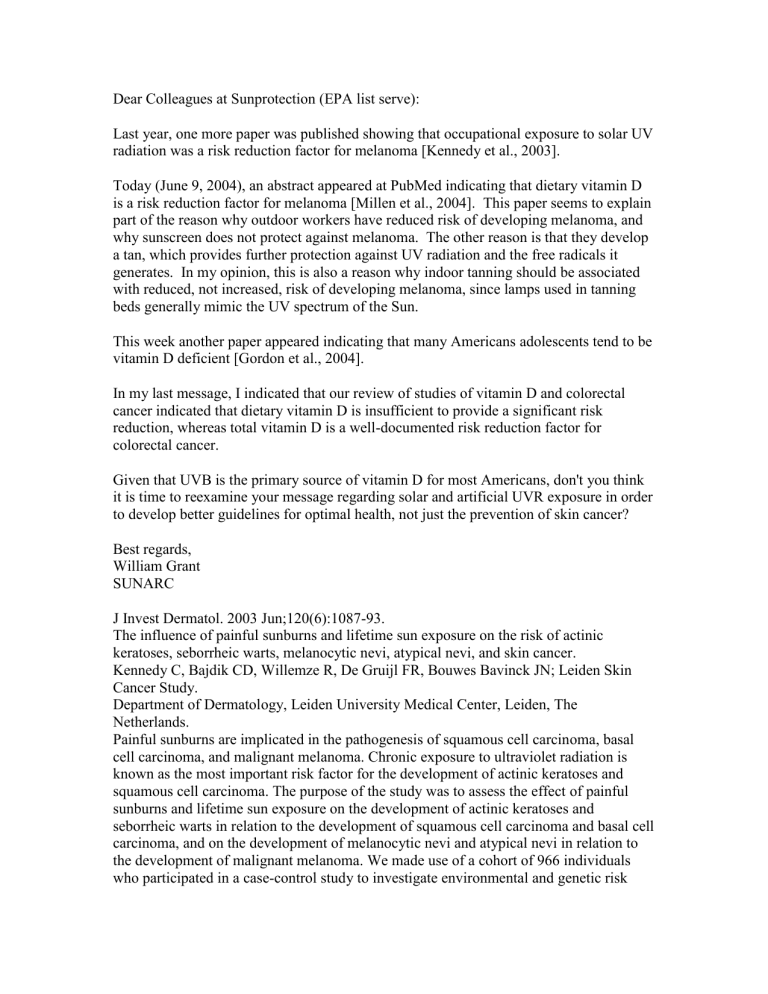
Dear Colleagues at Sunprotection (EPA list serve):
Last year, one more paper was published showing that occupational exposure to solar UV radiation was a risk reduction factor for melanoma [Kennedy et al., 2003].
Today (June 9, 2004), an abstract appeared at PubMed indicating that dietary vitamin D is a risk reduction factor for melanoma [Millen et al., 2004]. This paper seems to explain part of the reason why outdoor workers have reduced risk of developing melanoma, and why sunscreen does not protect against melanoma. The other reason is that they develop a tan, which provides further protection against UV radiation and the free radicals it generates. In my opinion, this is also a reason why indoor tanning should be associated with reduced, not increased, risk of developing melanoma, since lamps used in tanning beds generally mimic the UV spectrum of the Sun.
This week another paper appeared indicating that many Americans adolescents tend to be vitamin D deficient [Gordon et al., 2004].
In my last message, I indicated that our review of studies of vitamin D and colorectal cancer indicated that dietary vitamin D is insufficient to provide a significant risk reduction, whereas total vitamin D is a well-documented risk reduction factor for colorectal cancer.
Given that UVB is the primary source of vitamin D for most Americans, don't you think it is time to reexamine your message regarding solar and artificial UVR exposure in order to develop better guidelines for optimal health, not just the prevention of skin cancer?
Best regards,
William Grant
SUNARC
J Invest Dermatol. 2003 Jun;120(6):1087-93.
The influence of painful sunburns and lifetime sun exposure on the risk of actinic keratoses, seborrheic warts, melanocytic nevi, atypical nevi, and skin cancer.
Kennedy C, Bajdik CD, Willemze R, De Gruijl FR, Bouwes Bavinck JN; Leiden Skin
Cancer Study.
Department of Dermatology, Leiden University Medical Center, Leiden, The
Netherlands.
Painful sunburns are implicated in the pathogenesis of squamous cell carcinoma, basal cell carcinoma, and malignant melanoma. Chronic exposure to ultraviolet radiation is known as the most important risk factor for the development of actinic keratoses and squamous cell carcinoma. The purpose of the study was to assess the effect of painful sunburns and lifetime sun exposure on the development of actinic keratoses and seborrheic warts in relation to the development of squamous cell carcinoma and basal cell carcinoma, and on the development of melanocytic nevi and atypical nevi in relation to the development of malignant melanoma. We made use of a cohort of 966 individuals who participated in a case-control study to investigate environmental and genetic risk
factors for skin cancer. Exposure measurements for sunlight were collected and actinic keratoses, seborrheic warts, melanocytic nevi, and atypical nevi were counted. Relative risks were estimated using exposure odds ratios from cross-tabulation. Multivariate logistic regression was used to adjust for potential confounders. The recall of painful sunburns before the age of 20 y was associated with an increased risk of squamous cell carcinoma, nodular basal cell carcinoma, and multifocal superficial basal cell carcinoma as well as actinic keratoses. Odds ratios with 95% confidence intervals adjusted for age, sex, and skin type were 1.5 (0.97; 2.3); 1.6 (1.1; 2.2); 2.6 (1.7; 3.8); and 1.9 (1.4; 2.6) for the three types of nonmelanoma skin cancer and actinic keratoses, respectively. Painful sunburns before the age of 20 y were also associated with an increased risk of malignant melanoma and the development of its precursors, melanocytic nevi and atypical nevi.
Odds ratios with 95% confidence intervals adjusted for age, sex, and skin type were 1.4
(0.86; 2.1); 1.5 (1.1; 2.0); and 1.4 (0.88; 2.3) for malignant melanoma and the two types of precursors, respectively. Lifetime sun exposure was predominantly associated with an increased risk of squamous cell carcinoma (p-value for trend=0.03) and actinic keratoses
(p-value for trend <0.0001) and to a lesser degree with the two types of basal cell carcinoma. By contrast, lifetime sun exposure appeared to be associated with a lower risk of malignant melanoma, despite the fact that lifetime sun exposure did not diminish the number of melanocytic nevi or atypical nevi. Neither painful sunburns nor lifetime sun exposure were associated with an increased risk of seborrheic warts.
Cancer Epidemiol Biomarkers Prev. 2004 Jun;13(6):1042-51.
Diet and melanoma in a case-control study.
Millen AE, Tucker MA, Hartge P, Halpern A, Elder DE, Guerry D 4th, Holly EA,
Sagebiel RW, Potischman N.
Applied Research Program, Division of Cancer Control and Population Sciences,
National Cancer Institute, 6130 Executive Boulevard, MSC 7344, EPN 4005, Bethesda,
MD 20892-7344. millena@mail.nih.gov
BACKGROUND: Malignant melanoma has been one of the most rapidly increasing cancers within the United States with few modifiable risk factors. This study investigates risk related to dietary factors, which are potentially modifiable. METHODS: Newly diagnosed patients with melanoma (n = 502) were recruited from pigment lesion clinics and controls (n = 565) were recruited from outpatient clinics. To investigate the relationship between melanoma and dietary factors in this case-control study, study subjects were requested to complete a food frequency questionnaire, which assessed diet over the previous year. Using logistic regression, odds ratios (ORs) for melanoma were computed for nutrient and alcohol intake. RESULTS: Persons in high versus low quintiles of energy-adjusted vitamin D, alpha-carotene, beta-carotene, cryptoxanthin, lutein, and lycopene had significantly reduced risk for melanoma (ORs </= 0.67), which remained after adjustment for presence of dysplastic nevi, education, and skin response to repeated sun exposure. Addition of micronutrients from supplements did not add an additional reduction in risk. High alcohol consumption was associated with an increased risk for melanoma, which remained after adjustment for confounders [OR (95% confidence interval) in highest versus lowest quintiles, 1.65 (1.09-2.49)].
CONCLUSIONS: Diets consisting of foods rich in vitamin D and carotenoids and low in
alcohol may be associated with a reduction in risk for melanoma. These analyses should be repeated in large, prospective studies.
Arch Pediatr Adolesc Med. 2004 Jun;158(6):531-7.
Prevalence of vitamin d deficiency among healthy adolescents.
Gordon CM, DePeter KC, Feldman HA, Grace E, Emans SJ.
Divisions of Adolescent/Young Adult Medicine and Endocrinology and the Clinical
Research Program, Children's Hospital Boston and Harvard Medical School, Boston,
Mass.
BACKGROUND: Although vitamin D deficiency has been documented as a frequent problem in studies of young adults, elderly persons, and children in other countries, there are limited data on the prevalence of this nutritional deficiency among healthy US teenagers. OBJECTIVE: To determine the prevalence of vitamin D deficiency in healthy adolescents presenting for primary care. DESIGN: A cross-sectional clinic-based sample.
SETTING: An urban hospital in Boston. PARTICIPANTS: Three hundred seven adolescents recruited at an annual physical examination to undergo a blood test and nutritional and activity assessments. MAIN OUTCOME MEASURES: Serum levels of
25-hydroxyvitamin D (25OHD) and parathyroid hormone, anthropometric data, nutritional intake, and weekly physical activity and lifestyle variables that were potential risk factors for hypovitaminosis D. RESULTS: Seventy-four patients (24.1%) were vitamin D deficient (serum 25OHD level, </=15 ng/mL [</=37.5 nmol/L]), of whom 14
(4.6%) were severely vitamin D deficient (25OHD level, </=8 ng/mL [</=20 nmol/L]).
By using a broader definition (25OHD level, </=20 ng/mL [</=50 nmol/L]), 129 patients
(42.0%) were vitamin D insufficient. Serum 25OHD levels were inversely correlated with parathyroid hormone levels (r = -0.29), and were 24% lower during winter compared with summer. In a final multivariate model, season, ethnicity, milk and juice consumption, body mass index, and physical activity were significant independent predictors of hypovitaminosis D. CONCLUSIONS: Vitamin D deficiency was present in many US adolescents in this urban clinic-based sample. The prevalence was highest in
African American teenagers and during winter, although the problem seems to be common across sex, season, and ethnicity.

